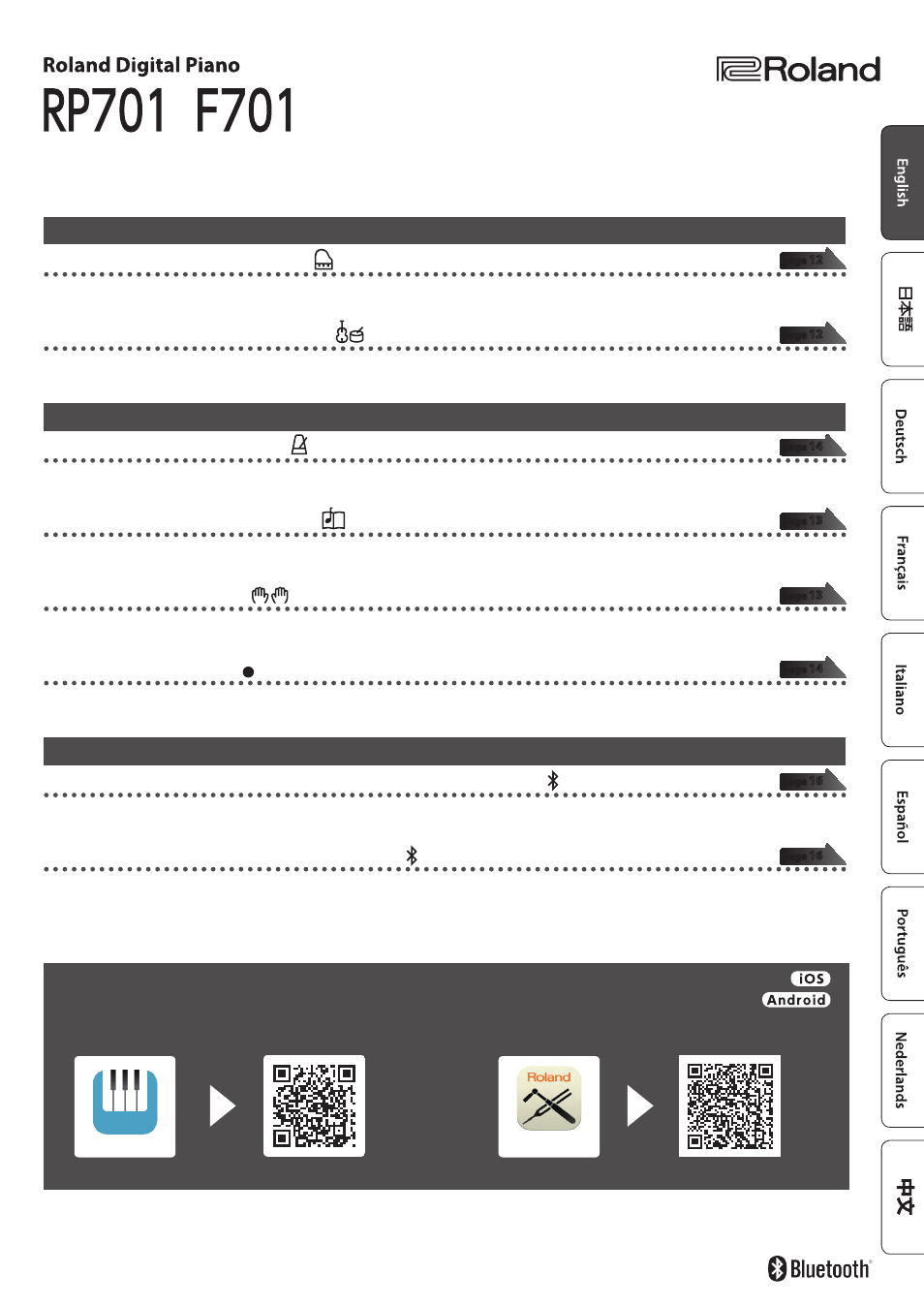Roland F701 88-Key Modern Digital Piano with Stand and Bench (White) User Manual
Download the apps, Owner’s manual

Owner’s Manual
© 2020 Roland Corporation
Before using this unit, carefully read “USING THE UNIT SAFELY” and “IMPORTANT NOTES” (leaflet “USING THE UNIT SAFELY” and Owner’s Manual
(p. 44)). After reading, keep the document(s) where it will be available for immediate reference.
What You Can Do with the RP701/F701
Play the Piano
˙
Play the piano sounds of your dream
This piano contains a variety of piano tones ranging from concert grand piano to upright piano.
It also contains the sound of a harpsichord, which is the ancestor of the piano. You’ll be sure to find piano sounds to your taste.
˙
Play string, organ, and percussion tones
You can also choose tones of instruments other than piano. Using tones other than the usual choices can provide a pleasant change, or
you can layer other tones with a piano tone to enjoy especially rich sonorities.
Practice songs
˙
Practice along with a metronome
You can practice while listening to a metronome. By changing the tempo or time signature as appropriate for the song you’re playing,
you can improve your ability to keep the rhythm.
˙
Practice along with the internal songs
Built into this piano are numerous well-known songs in a variety of genres such as classical, jazz, and practice pieces. You can listen to
these internal songs as models, or adjust the tempo and practice along with them.
˙
Practice one hand at a time
By playing back a song with the sound of the right-hand or left-hand part muted, you can hear the performance one hand at a time.
This also lets you practice along with the song one hand at a time.
˙
Record your performance
You can listen again to your own performance that you just recorded, and use it to improve your next performance. You can also save
your performance for your family member or piano teacher to hear.
Take advantage of Bluetooth
˙
Play back music through the piano’s speakers (Bluetooth audio function)
You can connect a smartphone or tablet, and listen to your favorite songs through the piano’s speakers. By performing along with a
song, you can enjoy being part of your favorite music.
˙
Use with piano with apps (Bluetooth MIDI function)
You can use an app to find new musical scores, and use the practice support functions to experience new possibilities in piano
performance.
This app lets you download musical scores and practice songs.
This app lets you customize the piano sound to your taste.
Download the apps
Download these smartphone/tablet apps and use them with your piano.
Piano Every Day
Piano Designer
Document Outline
- Contents
- Quick Operation
- Panel Descriptions
- Before You Play
- Panel Descriptions
- Before You Play
- Playing
- Listening to Songs
- Practicing/Recording
- Connecting a Mobile Device via Bluetooth
- Connecting a Mobile Device via Bluetooth
- Reference
- Connecting the Equipment
- Playing
- Listening to Songs
- Recording Your Performance
- Creating Your Own Piano Tone (Piano Designer)
- Connecting the Piano and a Mobile Device via Bluetooth
- Convenient Functions
- Making Various Settings (Function Mode)
- Basic Settings in Function Mode
- Turning the Bluetooth Function On/Off (Bluetooth On/Off)
- Adjusting the Volume of Bluetooth Audio (Input/Bluetooth Vol.)
- Playing Different Tones with the Left and Right Hand (p. 19)
- Playing Two Tones Layered on Each Key (p. 19)
- Dividing the Keyboard for Two People (Twin Piano)
- Transposing the Pitch of the Song Playback (Song Transpose)
- Adjusting the Song (SMF) Volume (Song Volume SMF)
- Adjusting the Song (Audio) Volume (Song Volume Audio)
- Adjusting the Volume of an Audio Playback Device (Input/Bluetooth Vol.)
- Adjusting the Volume from the Computer (USB Audio Input Volume)
- Setting the Song (SMF) Playback Mode (SMF Play Mode)
- Changing How the Pedal Effects Are Applied (Damper Pedal Part)
- Changing How the Pedals Work (Center Pedal)
- Changing the Effect of the Pedal (Left Pedal)
- Preventing Doubled Notes When Connected to a Sequencer (Local Control)
- MIDI Transmit Channel Settings (MIDI Transmit Ch.)
- Changing the Language Displayed in the Screen (Language)
- Adjusting the Brightness of the Display (Display Contrast)
- Specifying the Time Until the Operating Panel Dims (Screen Saver)
- Specifying a Maximum Volume (Volume Limit)
- Outputting Sound Both from Headphones and Internal Speakers (Speaker Auto Mute)
- Making the Power Automatically Turn off After a Time (Auto Off)
- Saving Settings Automatically (Auto Memory Backup)
- Settings Saved Even If the Power Is Turned Off
- Basic Settings in Function Mode
- Troubleshooting
- Error Messages
- Tone List
- Internal Song List
- USING THE UNIT SAFELY
- IMPORTANT NOTES
- Index
